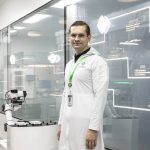A group of scientists from the United States and Taiwan say they have developed a test that can detect whether someone has COVID-19 in 1 second.
The research published this week in the Journal of Vacuum Science & Technology B says researchers from the University of Florida and Taiwan’s National Chiao Tung University report they’ve created a rapid and sensitive testing method for COVID-19 biomarkers.
Currently, the fastest reported results detecting positive signs of infection run anywhere from 5 to 10 minutes.
The research is being done by scientists who have previously worked on methods to detect biomarkers relevant to the Zika virus, heart attacks, and cerebral spinal fluid leaks. They used that experience to develop a sensor system they say can detect an infection almost immediately.
“A very fast test would be welcome technology wherever outbreaks are occurring, so long as it is accurate, easy to use, and widely accessible,” Dr. William Li, a COVID-19 researcher and the president and medical director of the Angiogenesis Foundation, told Healthline.
“A fast COVID-19 test would be useful in a doctor’s office, an urgent care facility, and a hospital emergency room,” Li said. “But it could also be useful at the airport or a hotel at check-in, or part of clearance to a worksite or to an indoor event like a concert or a theater. The key to COVID testing throughout the pandemic has always been accuracy and availability.”
How the test works
Minghan Xian, a chemical engineering doctoral candidate at the University of Florida, is one of the study’s authors. He works with a research group at the university.
Xian said in a statement that the test detects the coronavirus by amplifying the number of biomarkers, such as copies of viral ribonucleic acid (which is done in the commonly used polymerase chain reaction technique to detect COVID-19), or by amplifying the binding signal for a target biomarker.
“This could alleviate slow COVID-19 testing turnaround time issues,” Xian said. “Our biosensor strip is similar to commercially available glucose test strips in shape, with a small microfluidic channel at the tip to introduce our test fluid. With the microfluidic channel, a few electrodes are exposed to fluid. One is coated with gold and COVID-relevant antibodies are attached to the gold surface via a chemical method.”
Sensor strips connect to a circuit board. A short electrical test signal is sent between the gold electrode coated with coronavirus antibodies and another auxiliary electrode. The signal returns to the circuit board for quick analysis.
“Our sensor system, a circuit board, uses a transistor to amplify the electrical signal, which then gets converted into a number on the screen,” Xian said. “The magnitude of this number depends on the concentration of antigen, the viral protein, present within our test solution.”
The sensor strips have to be disposed of after each test, but the circuit board is reusable. Xian said the system’s versatility can stretch beyond testing for COVID-19.
“By altering the type of antibodies attached to the gold surface, we can repurpose the system to detect other diseases,” Xian said. “The system can serve as a prototype for modularized, inexpensive protein biomarker sensors for expedient real-time feedback within clinical applications, operating rooms, or home use.”






